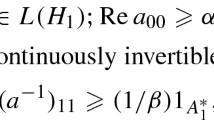Abstract
We investigate pinning regions and unpinning asymptotics in nonlocal equations. We show that phenomena are related to but different from pinning in discrete and inhomogeneous media. We establish unpinning asymptotics using geometric singular perturbation theory in several examples. We also present numerical evidence for the dependence of unpinning asymptotics on regularity of the nonlocal convolution kernel.











Similar content being viewed by others
Notes
In this sense, the profiles have countably many discontinuities at locations \(x\in \mathbb {Z}\).
The middle branch is normally hyperbolic except for the fold points, as well, and normally stable, but of less relevance to us, here.
Discretization details: \(dt=0.17\), \(dx=0.007324\), on \(|x|\le 30\); best-fit slopes using 4th to 8th smallest data points.
Discretization details: \(dt=0.17\), \(dx=0.007324\), on \(|x|\le 30\); best-fit slopes using 4th to 8th smallest data points.
Discretization details: We used \(2^{13}\) Fourier modes, \(dt=0.17\), \(|x|\le 30\); best-fit slopes using 4th to 8th smallest data points.
Discretization details: We used \(2^{13}\) Fourier modes, \(dt=0.17\), \(|x|\le 30\); best-fit slopes using 4th to 8th smallest data points.
Discretization details: We used \(2^{13}\) Fourier modes, \(dt=0.17\), \(|x|\le 30\); best-fit slopes using 4th to 8th smallest data points.
References
Bates, P., Fife, P., Ren, X., Wang, X.: Traveling waves in a convolution model for phase transitions. Arch. Ration. Mech.Anal. 138, 105–136 (1997)
Broer, H., Kaper, T., Krupa, M.: Geometric desingularization of a cusp singularity in slow-fast systems with applications to Zeeman’s examples. J. Dyn. Differ. Equ. 25, 925–958 (2013)
Carpio, A., Bonilla, L.: Wave front depinning transition in discrete one-dimensional reaction diffusion systems. Phys. Rev. Lett. 86(26), 6034–6037 (2001)
Chen, X.: Existence, uniqueness, and asymptotic stability of traveling waves in nonlocal evolution equations. Adv. Differ. Equ. 2, 125–160 (1997)
Chmaj, A.: Existence of traveling waves in the fractional bistable equation. Arch. Math. 100, 473–480 (2013)
Faye, G., Scheel, A.: Fredholm properties of nonlocal differential operators via spectral flow. Indiana Univ. Math. J. 63, 1311–1348 (2014)
Faye, G., Scheel, A.: Existence of pulses in excitable media with nonlocal coupling. Adv. Math. 270, 400–456 (2015)
Fenichel, N.: Geometric singular perturbation theory for ordinary differential equations. J. Differ. Equ. 31, 53–98 (1979)
Krupa, M., Szmolyan, P.: Geometric singular perturbation theory to nonhyperbolic points: fold and canard points in two dimensions. SIAM J. Math. Anal. 33, 286–314 (2001)
Mishchenko, E., Kolesov, Y., Kolesov, A., Rozov, N.: Asymptotic Methods in Singularly Perturbed Systems. Monogr. Contemp. Math, Consultants Bureau, New York (1994)
Scheel, A., van Vleck, E.: Lattice differential equations embedded into reaction–diffusion systems. Proc. R. Soc. Edinb. A 139A, 193–207 (2009)
Szmolyan, P., Wechselberger, M.: Relaxation oscillations in \(\mathbb{R}^3\). J. Differ. Equ. 200, 69–104 (2004)
van Gils, S., Krupa, M., Szmolyan, P.: Asymptotic expansions using blow-up. ZAMP 56(3), 369–397 (2005)
Acknowledgments
This research was conducted during Summer 2014 in the REU: Complex Systems at the University of Minnesota Department of Mathematics, funded by the National Science Foundation (DMS-1311414) and (DMS-1311740).
Author information
Authors and Affiliations
Corresponding author
Appendix: Passage Through an Inflection Point
Appendix: Passage Through an Inflection Point
In this appendix, we prove some results stated in Sect. 3.2 for the system of differential equations
This system was obtained after some scalings in the study of the slow passage through an inflection point.
Proposition 6.1
For the system (6.1), the following results hold.
-
(i)
There exists a unique trajectory \(\gamma _0\) in the (u, w)-plane such that \(u(t)^3-w(t)\rightarrow 0\) for \(t\rightarrow \pm \infty \).
-
(ii)
The Cauchy Principal Value \(C_0\) of u exists and
$$\begin{aligned} C_0 := P.V. \int _\mathbb {R}u(t)\mathrm {d}t<0. \end{aligned}$$
Proof
We first start by setting \(w_{1,-}:=w^{-\frac{1}{3}}\) and \(u_{1,-}:=uw^{-\frac{1}{3}}\) for \(w>0\) (respectively \(w_{1,+}\) and \(u_{1,+}\) for \(w<0\)) such that system (6.1) is transformed into two systems
Now, rescaling time such that \(w_{1,\pm }^2 \frac{\mathrm {d}}{\mathrm {d}t}:=\frac{\mathrm {d}}{\mathrm {d}s}\), we obtain
Note that each system possesses a unique equilibrium given by \((w_{1,\pm },u_{1,\pm })=(0,1)\), corresponding to the “equilibrium” \((w,u)=(\pm \infty ,\pm \infty )\) in system (6.1). The linearization at (0, 1) for each system is given by the Jacobian matrix
As a consequence, for any \(k\ge 2\), there exists a \(\mathcal {C}^k\) center manifold \(\mathcal {M}_{1,\pm }\), given locally, as a graph of form
where \(\mathcal {V}_\pm \) is a neighborhood of the origin in \(\mathbb {R}^\mp \), and \(\Psi _\pm \) is \(\mathcal {C}^k\), with Taylor expansion
\(\square \)
We also note that \(u_{1,-}\frac{\mathrm {d}}{\mathrm {d}s}u_{1,-}>0\) provided that \(u_{1,-}\) is large enough and \(w_{1,-}>0\). As a consequence, \(u_{1,-}\) stays bounded as we solve backward in time and using Poincaré-Bendixson Theorem we obtain the following result and its corollary.
Lemma 6.2
Fix \(0<\delta \ll 1\). Any trajectory of system (6.3) with initial condition \((w_{1,-},u_{1,-})=(\delta ,u_{1,-}^0)\), \(u_{1,-}^0\) arbitrary, converges backward in time to (0, 1).
Corollary 6.3
The asymptotics for \(s\longrightarrow -\infty \) are given by the center manifold (6.4) and (6.5), up to exponential corrections.
Finally, we remark that \(u_{1,+} \ge 1\) is locally backward invariant since
And for \(-S \le s \le S\), \(S>0\) fixed, solving backward in time, we have that solutions exist (\(u_{1,\pm }^2\) decreases when large).
As a consequence, we have the existence of a unique trajectory (w, u) for system (6.1) with
and asymptotics
as \(t \longrightarrow \pm \infty \). This further ensures that the Cauchy principal value \(C_0\) of u(t) exists. One easily checks that \(C_0<0\) and this concludes the proof of the proposition.\(\square \)
Rights and permissions
About this article
Cite this article
Anderson, T., Faye, G., Scheel, A. et al. Pinning and Unpinning in Nonlocal Systems. J Dyn Diff Equat 28, 897–923 (2016). https://doi.org/10.1007/s10884-016-9518-6
Received:
Revised:
Published:
Issue Date:
DOI: https://doi.org/10.1007/s10884-016-9518-6




